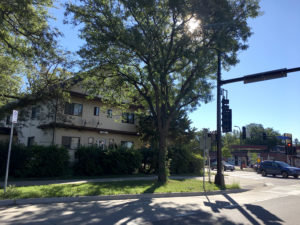By TESHA M. CHRISTENSON
The new five-story building proposed at 46th St. and Minnehaha Ave. will be affordable by design, according to developer Sean Sweeney of Hayes Harlow Development.
While working for eight years in San Francisco, Sweeney was a part of affordable housing and market-rate projects, and saw the challenges of both, he told citizens gathered at a community meeting on Oct. 9. In Minneapolis, he continues to hear that the city needs more affordable housing, but he pointed out that getting the federal subsidies and tax credits for those projects can be very time-consuming.
 Photo right: The existing building at the corner of 46th St. and Minnehaha Ave. offers 12 transitional housing units that share four bathrooms with low-cost rents ranging from $450-650 a month. Sweeney said they considered keeping the building, but determined it was too run-down to rehabilitate. It will be replaced with a five-story structure that will have 54 apartments and retail space on the first floor. (Photo by Tesha M. Christensen)
Photo right: The existing building at the corner of 46th St. and Minnehaha Ave. offers 12 transitional housing units that share four bathrooms with low-cost rents ranging from $450-650 a month. Sweeney said they considered keeping the building, but determined it was too run-down to rehabilitate. It will be replaced with a five-story structure that will have 54 apartments and retail space on the first floor. (Photo by Tesha M. Christensen)
Instead, he has decided to construct buildings that are affordable by design. “We’re building smaller units,” he said, “and keep the building tight, simple and efficient.” This helps keep rents lower, Sweeney explained.
A new, 38,452-square-foot building will replace an existing structure that Sweeney said he’s been told is an “eyesore in the community.”
The existing building has 12 transitional housing units that share four bathrooms with rents ranging from $450-650 a month. Sweeney said they considered keeping the building, but determined it was too run-down to rehabilitate. The mechanicals needed to be upgraded and additional bathrooms would be needed.
This project does not include the building that houses Solid State Records on the east.
54 units, 27 parking stalls
According to Sweeney, when they approach a new site, they ask the following questions: What is most needed? What is the best use at this site?
At Minnehaha and 46th, they determined the need was housing units and commercial space. They were drawn to the site because of its proximity to the light rail station and bus lines, and believe that most of their building residents will use transit instead of their vehicles.
“We think this is a great area,” said Sweeney.
 Photo left: Pete Keely of Collage Architects (left) and Sean Sweeney of Hayes Harlow Development explain their development proposal during a community meeting on Oct. 9. (Photo by Tesha M. Christensen)
Photo left: Pete Keely of Collage Architects (left) and Sean Sweeney of Hayes Harlow Development explain their development proposal during a community meeting on Oct. 9. (Photo by Tesha M. Christensen)
The current plan calls for 54 housing units spread out over five floors, with 2,900 square feet in retail space on the first level along 46th. A parking lot with 27 units is planned for the back of the property with access off the alley, along with parking for one bike per unit.
“We looked at underground parking,” noted architect Pete Keely of Collage Architects. “But we get about as much and we save $600,000-700,000 by not going underground.”
 Photo right: A new, 38,452-square-foot building proposed at 46th St. and Minnehaha Ave. will offer studio, one-bedroom and two-bedroom units with rents expected to range from $900 to $1,200. (Graphic submitted)
Photo right: A new, 38,452-square-foot building proposed at 46th St. and Minnehaha Ave. will offer studio, one-bedroom and two-bedroom units with rents expected to range from $900 to $1,200. (Graphic submitted)
Other buildings in the metro area that Sweeney has developed that have fewer cars than residents include the Ray Apartments in St. Paul, the Lyndy in Lyn-Lake in Minneapolis and the Central in Minneapolis. “There are proposals on the table in the city for projects with 49 units in two separate locations that are planning no parking at all. The city is very supportive of the reduced parking requirements,” stated Sweeney.
They anticipate adding 15-20 cars a day to the local traffic.
Stepped-back design
In order to avoid placing a tall, five-story wall next to residences on the north side, developers have proposed a stepped-back design that moves from five foot from the property line on the first floor to 11 feet away to 30 feet away on the upper floors."
With that approach, the first floor is 9,982 square feet, the second and third floors 9,465, the fourth floor 8,296, and the fifth floor 7,283.
Units on the first floor will resemble townhouses with walk-up entries and space for a garden and patio in front.
Studio, one-bedroom and two-bedroom units will be available with rents expected to range from $900 to $1,200. One-bedrooms at the nearby Oppidan/Cub development are expected to start at $1,200, Sweeney pointed out in comparison.
Storage is planned for the center of the building. There will be a small, 10x20 roof deck on the top floor.
Construction will likely begin next April and last 10-11 months with completion in early 2020.
Smaller units, more affordable
“I think the trend will continue to focus on smaller units and affordability,” stated Sweeney. “I believe people want to live in great neighborhoods and those neighborhoods will be ones that feature a multitude of housing options at different price points, walkability, transit, and neighborhood-serving commercial. The creation of those neighborhoods will hopefully work to improve people’s live, reduce car dependency and help combat climate change.”
The Neighborhood Development and Transportation Committee will consider this proposal at its Nov. 8 meeting and decide whether to provide a letter of support.
Comments
No comments on this item Please log in to comment by clicking here